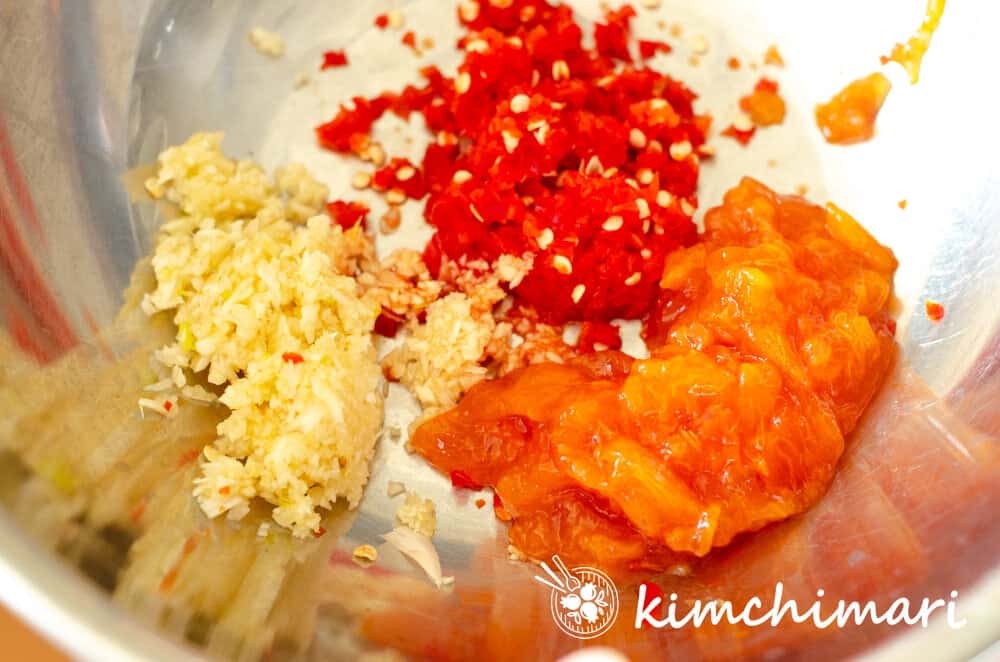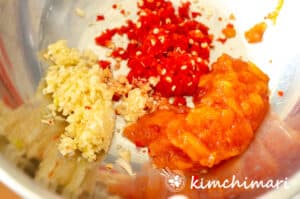Fresh Kimchi (Geotjeori) recipe that’s so simple and easy to make!! It’s also refreshing, light and so pleasantly flavorful. It’s made with just 6 ingredients using fresh Fresno red chili pepper which gives it quite a spicy kick while still keeping the flavors bright.

What is Fresh Kimchi (Geotjeori)?
Fresh Kimchi is a kimchi that is served ‘fresh’ without any fermentation. In Korean we call this Geotjeori 겉절이 where geot 겉 means ‘outer layer’ and jeori 절이 means ‘pickled’ or ‘salted’. Unlike the standard kimchi where it usually goes through at least 2-3 days of fermentation before it’s ready to eat, this kimchi is meant to be eaten right after it’s seasoned.
What does Fresh Kimchi or Geotjeori taste like?
Fresh Kimchi is brighter and fresher tasting than fermented regular Kimchi. Although this kimchi is missing the tummy-clearing and sour, zingy taste that you get from typical probiotic-ladened fermented foods like yogurt, kombucha and of course ripened kimchi, it is still incredibly delicious in its own way.
It’s garlicky, spicy and slightly salty and sweet. Because I use ripe persimmon for the sweetness, it’s just ever so slightly naturally sweet in a very pleasant way. Texture-wise, the cabbage is tender and soft from the pickling but still has a tiny bit of crunch which you will love.
Napa cabbage (Baechu 배추)
A good napa cabbage for kimchi is one where the white parts of the leaves are not too thick. But it’s ok if you can’t find a perfect one.
Korean Solar Sea Salt (Cheonilyeom 천일염)
Using the right salt is one of the most important factors in producing good kimchi. Be sure to use SEA SALT and if you can, please buy Korean Sea Salt that’s been naturally dried in the sun (cheonilyeom) and the one that’s coarse for Kimchi making 김치용.
Please don’t use table salt, rock salt, or Himalayan rock salt.. if you absolutely can’t find Korean sea salt, then you can substitute Celtic Salt which I found to be the most similar in flavor and saltiness. You can read more about my Best Salt for Kimchi post where I compare 12 different salts for Kimchi making.
You can also read about my Korean Salt Guide if you want to know about all the different salts used in Korean cooking.
Fresno Red Chili
Although this is not a standard Korean chili pepper, it has a similar sweet and smoky flavor profile as the traditional Korean one so many Korean grocery markets sell them as a substitute because Korean American moms have started to use them to make Kimchi.
Fresno Chili is similar to Jalapeno peppers in terms of spiciness so Jalapeno can be used as a substitute but mature red Fresno chili has more flavor and less heat than Jalapeno so it works well in making Kimchi.
Persimmon
Persimmon comes in 2 different types – Fuyu and Hachiya. You can use both kinds for this recipe as long as both are fully ripe and soft. Since Fuyu is usually eaten when it’s still firm, if you are going to use Fuyu (like I did here), it’s best to use it when it’s overripe, very soft and mushy.
If you can’t get persimmon, you can substitute sugar to taste.
Fish Sauce
The most common fish sauce (Aekjeot 액젓) used in Kimchi is a sauce made from fermented anchovies which is called Myeolchi Aekjeot 멸치액젓. You can also use other Asian fish sauces such as 3 crabs brand fish sauce. I also sometimes use Kkanari Aekjeot 까나리 액젓 which is a fermented sauce made from sand lances.
How to make 6 Ingredient Fresh Kimchi (4 min) Video
Ingredients
- 2 lb Napa cabbage (approx 1 whole medium size)
- 1/2 cup Korean coarse sea salt (Cheonilyeom 천일염)
- 2-3 Serrano red chili peppers
- 3 Tbsp fresh chopped garlic
- 1 ripe persimmon (about 3 Tbsp) – Hachiya or Fuyu also works if very ripe and soft
- 2.5 to 3 Tbsp anchovy fish sauce (myeolchi aekjeot 멸치액젓)
OPTIONAL
- 4.5 cups water (if using brine to pickle)
- 2 green onions or 1/2 Korean Leek (Daepa 대파)
- sesame seeds
- sesame oil
- sugar – if needed
Step by Step Instructions

- Cut off 1/2 inch or so of the root end or head part so the leaves separate. Repeat cutting off the head and separating the leaves until all the leaves are loose and no longer attached.
- In a large bowl, prepare to layer and stack the leaves sprinkling salt in between the leaves. I know this part is hard if you have no feel for how much salt to put on each leaves but you basically want to spread out the salt evenly among the leaves. You can always go back and add more or take out some. Let it sit for 3 hrs or more until it passes the ‘bend test’.
- Alternatively, you can make a brine by mixing 1:9 ratio of salt:water in volume. e.g. 1 cup salt + 9 cups water. But if you use a brine, it takes longer to pickle the cabbages for about 5 hrs.
- Prepare the Yangnyeom 양념 (seasoning) :
- Persimmon – scoop out the flesh of a very ripe fruit and chop lightly. Persimmon should be very ripe, soft and mushy.
- Garlic, Fresh Chili – chop fresh garlic and chili pepper with a knife or a chopper. I used a chopper.
- After 3 hrs, check to see if the cabbage leaves are fully pickled. SEE VIDEO
Try to bend the thickest, white flesh part of the leaf – if it bends easily without breaking then it’s done!
- RINSE salted cabbage leaves in water 2-3 times and drain in a colander for 5 min or so.
- Once the leaves are fully drained, rip each leaf with your hands into smaller pieces. You can cut it with a knife but traditionally Koreans always rip the leaf by hand for Geotjeori so watch my video and try to rip it if you can. To me it just doesn’t feel the same if it’s cut by a knife. 😝
- In a bowl, add the ripped cabbage leaves then add chopped garlic, red chili, and persimmon from 3. Add fish sauce and mix well until leaves are all evenly coated. Optionally, you can also add some sliced green onions.
- Now it’s ready to eat!
- EXTRA – As a finish, AFTER you plate, sprinkle some sesame seeds and a swirl of sesame oil to the plated Geotjeori.

Answers from JINJOO!
FAQ
- How long will this kimchi keep? This kimchi is meant to be eaten FRESH and not meant to ferment. So it’s best to eat it the same day or at most within 2-3 days. Kimchi will not taste as good once it’s past a few days.
- Should I refrigerate Geotjeori? – store this kimchi in the fridge right away.
- What if I don’t have a Persimmon? If you can’t get a persimmon, you can add sugar or maesil syrup instead. I’ve tried it with both and although it still tastes good, it is just not the same as using persimmon in this recipe.
- What if I can’t get Fresno Chili? You can substitute using dried Korean red chili powder instead but again it loses the very bright and refreshing flavor of this special recipe.
Geotjeori without Fresh Fresno Chili
Because I know Fresno Chili may not always be easy to get, I have another version that I made with just Korean Gochugaru (red chili powder) instead of the fresh chili.
Ingredients – same as above except substitute 4 Tbsp Gochugaru and 2 tsp green plum (maesil) syrup if you have it. Or just add a bit of sugar. And here you go! FYI, the recipe above that uses Fresno chili is actually more spicy in flavor than this one below.. lol.
Fresh Cabbage Kimchi (Geotjeori)
Ingredients
- 2 lb Napa cabbage approx 1 whole medium size
- 1/2 cup Korean solar sea salt Cheonilyeom 천일염
- 2-3 Fresno red chili peppers
- 3 Tbsp fresh chopped garlic
- 1/2 ripe persimmon 1/2 persimmon is about 3 Tbsp – Hachiya or Fuyu also works if very ripe and soft
- 3 Tbsp fish sauce myeolchi aekjeot 멸치액젓 (fermented anchovy sauce)
OPTIONAL
- 4.5 cups water if using a brine to pickle
- 2 green onions or 1/2 Korean Leek Daepa 대파
- 1 tsp sesame seeds
- 1 tsp sesame oil
- 1/4 tsp sugar – if needed
Instructions
- Cut off 1/2 inch or so of the root end or head part so the leaves separate. Repeat cutting off the head and separating the leaves until all the leaves are loose and no longer attached together.2 lb Napa cabbage
- In a large bowl, prepare to layer and stack the leaves sprinkling salt in between the leaves. I know this part is kind of hard if you have no feel for how much salt to put on each leaves but you basically want to spread out the salt evenly among the leaves. You can always go back and add more or take out some. Let it sit for 3 hrs.1/2 cup Korean solar sea salt
- Alternatively, you can make a brine by mixing 1:9 ratio of salt:water in volume. e.g. 1 cup salt + 9 cups water. But if you use a brine, it takes longer to pickle the cabbages for about 5 hrs.4.5 cups water
Prepare Yangnyeom (Seasoning)
- Persimmon – scoop out the flesh of a very ripe fruit. The persimmon should be very soft and mushy.1/2 ripe persimmon
- Chop fresh garlic and chili pepper by knife or with a chopper.3 Tbsp fresh chopped garlic, 2-3 Fresno red chili peppers
- After 3 hrs, do a test by bending the white part of the leaves to see if it's ready to be rinsed. Once it's fully pickled, rinse the salted cabbage leaves in water a couple of times and let them drain in a colander for 5 min or so.
- Once the leaves are drained, rip each leaf with your hands into smaller pieces. You can cut it with a knife but traditionally Koreans always rip the leaf by hand for Geotjeori so watch my video and try to rip it if you can. To me it just doesn’t feel the same if it’s cut by a knife. 😝
- In a bowl, mix the ripped cabbage leaves then add garlic, red chili, fish sauce, persimmon and mix well until leaves are all evenly coated.3 Tbsp fish sauce
- Now it’s ready to eat! As a last optional finish, you can sprinkle some sesame seeds and a swirl of sesame oil to a plated Geotjeori if you’d like.1 tsp sesame seeds, 1 tsp sesame oil
Tips & Notes:
- The sodium level in the nutrition facts are totally an estimation as there’s no way for me to tell how much of the sodium in the salt is absorbed into the cabbage.
- Please don’t try to ferment this Kimchi. It should be consumed in 2-3 days and best to be eaten the same day.



 Try to bend the thickest, white flesh part of the leaf – if it bends easily without breaking then it’s done!
Try to bend the thickest, white flesh part of the leaf – if it bends easily without breaking then it’s done! 



























Leave a Review